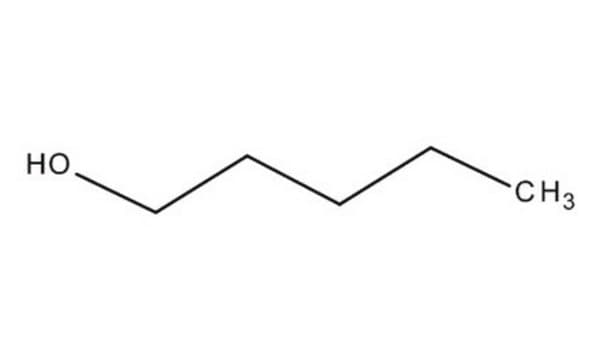W205605
1-Pentanol
≥99%, FG
Sinónimos:
1-Pentanol, n-Amyl alcohol, Pentyl alcohol
About This Item
Productos recomendados
origen biológico
synthetic
grado
FG
Fragrance grade
Agency
follows IFRA guidelines
meets purity specifications of JECFA
cumplimiento norm.
EU Regulation 1223/2009
EU Regulation 1334/2008 & 872/2012
FDA 21 CFR 172.515
FDA 21 CFR 176.180
FDA 21 CFR 176.210
densidad de vapor
3 (vs air)
presión de vapor
1 mmHg ( 13.6 °C)
1.5 mmHg ( 20 °C)
Ensayo
≥99%
Formulario
liquid
temp. de autoignición
572 °F
lim. expl.
10 %, 100 °F
índice de refracción
n20/D 1.409 (lit.)
bp
136-138 °C (lit.)
mp
−78 °C (lit.)
densidad
0.811 g/mL at 25 °C (lit.)
aplicaciones
flavors and fragrances
Documentación
see Safety & Documentation for available documents
alérgeno alimentario
no known allergens
alérgeno de la fragancia
no known allergens
Organoléptico
pungent; chemical; wine-like
cadena SMILES
CCCCCO
InChI
1S/C5H12O/c1-2-3-4-5-6/h6H,2-5H2,1H3
Clave InChI
AMQJEAYHLZJPGS-UHFFFAOYSA-N
¿Está buscando productos similares? Visita Guía de comparación de productos
Categorías relacionadas
Descripción general
Aplicación
- Process-specified emission factors and characteristics of VOCs from the auto-repair painting industry.: This article evaluates the emission factors and characteristics of various volatile organic compounds, including amyl alcohol, in auto-repair painting, significant for environmental biochemistry and safety assessments (Xiao et al., 2024).
Palabra de señalización
Danger
Frases de peligro
Consejos de prudencia
Clasificaciones de peligro
Acute Tox. 4 Inhalation - Eye Dam. 1 - Flam. Liq. 3 - Skin Irrit. 2 - STOT SE 3
Órganos de actuación
Respiratory system
Código de clase de almacenamiento
3 - Flammable liquids
Clase de riesgo para el agua (WGK)
WGK 1
Punto de inflamabilidad (°F)
120.2 °F - closed cup
Punto de inflamabilidad (°C)
49 °C - closed cup
Equipo de protección personal
Eyeshields, Faceshields, Gloves, type ABEK (EN14387) respirator filter
Elija entre una de las versiones más recientes:
¿Ya tiene este producto?
Encuentre la documentación para los productos que ha comprado recientemente en la Biblioteca de documentos.
Los clientes también vieron
Nuestro equipo de científicos tiene experiencia en todas las áreas de investigación: Ciencias de la vida, Ciencia de los materiales, Síntesis química, Cromatografía, Analítica y muchas otras.
Póngase en contacto con el Servicio técnico













